Coupling Coordination Relationships Between Ecosystems and Economic Development in Qinghai and Tibet
Abstract
1. Introduction
2. Materials and Methods
2.1. Study Area
2.2. Data Sources
2.3. Research Methodology
2.3.1. Indicators of Ecological Vulnerability
2.3.2. Evaluation Index System of Economic Development Level
2.3.3. CRITIC Method
2.3.4. Obstacle Degree Model
2.3.5. Coupling Coordination Model
2.3.6. The Geodetector Method
3. Analysis of Results
3.1. Characteristics of the Spatial Distribution of Ecological Vulnerability in Qinghai and Tibet
3.2. Spatial Distribution Characteristics of Economic Development in Qinghai and Tibet
3.3. Coupling and Coordination Relationships and Driving Factors Between Ecological Vulnerability and Economic Development Level
3.3.1. Analysis of the Coupling Coordination Results
3.3.2. Driving Factor Analysis
3.4. Models and Strategies of Development
4. Discussion
5. Conclusions
Author Contributions
Funding
Data Availability Statement
Conflicts of Interest
References
- Mayer, A.L.; Donovan, R.P.; Pawlowski, C.W. Information and entropy theory for the sustainability of coupled human and natural systems. Ecol. Soc. 2014, 19, 11. [Google Scholar] [CrossRef]
- Liu, J.; Mooney, H.; Hull, V.; Davis, S.J.; Gaskell, J.; Hertel, T.; Lubchenco, J.; Seto, K.C.; Gleick, P.; Kremen, C.; et al. Systems integration for global sustainability. Science 2015, 347, 1258832. [Google Scholar] [CrossRef] [PubMed]
- Verburg, P.H.; Crossman, N.; Ellis, E.C.; Heinimann, A.; Hostert, P.; Mertz, O.; Nagendra, H.; Sikor, T.; Erb, K.-H.; Golubiewski, N.; et al. Land system science and sustainable development of the earth system: A global land project perspective. Anthropocene 2015, 12, 29–41. [Google Scholar] [CrossRef]
- Hull, V.; Tuanmu, M.; Liu, J. Synthesis of human-nature feedbacks. Ecol. Soc. 2015, 20, 17. [Google Scholar] [CrossRef]
- Noh, J.K.; Echeverria, C.; Gaona, G.; Kleemann, J.; Koo, H.; Fuerst, C.; Cuenca, P. Forest Ecosystem Fragmentation in Ecuador: Challenges for Sustainable Land Use in the Tropical Andean. Land 2022, 11, 287. [Google Scholar] [CrossRef]
- Krsnik, G.; Reyes-Paecke, S.; Reynolds, K.M.; Garcia-Gonzalo, J.; Olabarria, J.R.G. Assessing Relativeness in the Provision of Urban Ecosystem Services: Better Comparison Methods for Improved Well-Being. Land 2023, 12, 88. [Google Scholar] [CrossRef]
- Kubalíková, L. Cultural Ecosystem Services of Geodiversity: A Case Study from Stranska skala (Brno, Czech Republic). Land 2020, 9, 105. [Google Scholar] [CrossRef]
- Varis, O.; Taka, M.; Kummu, M. The planet’s stressed river basins: Too much pressure or too little adaptive capacity? Earth’s Future 2019, 7, 1118–1135. [Google Scholar] [CrossRef]
- Winkler, K.; Fuchs, R.; Rounsevell, M.; Herold, M. Global land use changes are four times greater than previously estimated. Nat. Commun. 2021, 12, 2501. [Google Scholar] [CrossRef]
- Fu, B. Coupling human and natural systems for sustainable development. Natl. Sci. Rev. 2023, 10, nwad086. [Google Scholar] [CrossRef]
- Fan, Y.; Fang, C.; Zhang, Q. Coupling coordinated development between social economy and ecological environment in Chinese provincial capital cities-assessment and policy implications. J. Clean. Prod. 2019, 229, 289–298. [Google Scholar] [CrossRef]
- Tomal, M. Evaluation of coupling coordination degree and convergence behaviour of local development: A spatiotemporal analysis of all Polish municipalities over the period 2003–2019. Sustain. Cities Soc. 2021, 71, 102992. [Google Scholar] [CrossRef]
- Ariken, M.; Zhang, F.; Chan, N.w.; Kung, H.-t. Coupling coordination analysis and spatio-temporal heterogeneity between urbanization and eco-environment along the Silk Road Economic Belt in China. Ecol. Indic. 2021, 121, 107014. [Google Scholar] [CrossRef]
- Mondal, K.; Chatterjee, C.; Singh, R. Examining the coupling and coordination of water-energy-food nexus at a sub-national scale in India—Insights from the perspective of Sustainable Development Goals. Sustain. Prod. Consum. 2023, 43, 140–154. [Google Scholar] [CrossRef]
- Han, D.; Yu, D.; Qiu, J. Assessing coupling interactions in a safe and just operating space for regional sustainability. Nat. Commun. 2023, 14, 1369. [Google Scholar] [CrossRef]
- Qiu, J.; Liu, Y.; Chen, C.; Huang, Q. Spatial structure and driving pathways of the coupling between ecosystem services and human well-beings: A case study of Guangzhou. J. Nat. Resour. 2023, 38, 760–778. [Google Scholar] [CrossRef]
- Li, L.; Fan, Z.; Feng, W.; Yuxin, C.; Keyu, Q. Coupling coordination degree spatial analysis and driving factor between socio-economic and eco-environment in northern China. Ecol. Indic. 2022, 135, 108555. [Google Scholar] [CrossRef]
- Tu, D.; Cai, Y.; Liu, M. Coupling coordination analysis and spatiotemporal heterogeneity between ecosystem services and new-type urbanization: A case study of the Yangtze River Economic Belt in China. Ecol. Indic. 2023, 154, 110535. [Google Scholar] [CrossRef]
- Zhang, H.; Wang, Y.; Wang, C.; Yang, J.; Yang, S. Coupling analysis of environment and economy based on the changes of ecosystem service value. Ecol. Indic. 2022, 144, 109524. [Google Scholar] [CrossRef]
- Zhang, K.; Jin, Y.; Li, D.; Wang, S.; Liu, W. Spatiotemporal variation and evolutionary analysis of the coupling coordination between urban social-economic development and ecological environments in the Yangtze River Delta cities. Sustain. Cities Soc. 2024, 111, 105561. [Google Scholar] [CrossRef]
- Liu, J.Y.; Qin, K.Y.; Xie, G.D.; Xiao, Y.; Huang, M.D.; Gan, S. Is the ‘water tower’ reassuring? Viewing water security of Qinghai-Tibet Plateau from the perspective of ecosystem services ‘supply-flow-demand’. Environ. Res. Lett. 2022, 17, 094043. [Google Scholar] [CrossRef]
- Wu, J.H.; Wang, G.Z.; Chen, W.X.; Pan, S.P.; Zeng, J. Terrain gradient variations in the ecosystem services value of the Qinghai-Tibet Plateau, China. Glob. Ecol. Conserv. 2022, 34, e02008. [Google Scholar] [CrossRef]
- Pan, Y.; Zhu, J.; Zhang, Y.J.; Li, Z.N.; Wu, J.X. Poverty eradication and ecological resource security in development of the Tibetan Plateau. Resour. Conserv. Recycl. 2022, 186, 106552. [Google Scholar] [CrossRef]
- Xu, P.; Yan, D.H.; Weng, B.S.; Bian, J.M.; Wu, C.; Wang, H. Evolution trends and driving factors of groundwater storage, recharge, and discharge in the Qinghai-Tibet Plateau: Study progress and challenges. J. Hydrol. 2024, 631, 130815. [Google Scholar] [CrossRef]
- Zhao, H.; Wei, D.; Wang, X.D.; Hong, J.T.; Wu, J.B.; Xiong, D.H.; Liang, Y.L.; Yuan, Z.R.; Qi, Y.H.; Huang, L. Three decadal large-scale ecological restoration projects across the Tibetan Plateau. Land Degrad. Dev. 2024, 35, 22–32. [Google Scholar] [CrossRef]
- Anniwaer, N.; Li, X.Y.; Wang, K.; Xu, H.; Hong, S.B. Shifts in the trends of vegetation greenness and photosynthesis in different parts of Tibetan Plateau over the past two decades. Agric. For. Meteorol. 2024, 345, 109851. [Google Scholar] [CrossRef]
- Bafitlhile, T.M.; Liu, Y.B. Temperature contributes more than precipitation to the greening of the Tibetan Plateau during 1982-2019. Theor. Appl. Climatol. 2022, 147, 1471–1488. [Google Scholar] [CrossRef]
- An, R.; Wang, H.L.; Feng, X.Z.; Wu, H.; Wang, Z.; Wang, Y.; Shen, X.J.; Lu, C.H.; Quaye-Ballard, J.A.; Chen, Y.H.; et al. Monitoring rangeland degradation using a novel local NPP scaling based scheme over the “Three-River Headwaters” region, hinterland of the Qinghai-Tibetan Plateau. Quat. Int. 2017, 444, 97–114. [Google Scholar] [CrossRef]
- Beroya-Eitner, M.A. Ecological vulnerability indicators. Ecol. Indic. 2016, 60, 329–334. [Google Scholar] [CrossRef]
- Christer, N.; Gunnell, G. The Fragility of Ecosystems: A Review. J. Appl. Ecol. 1995, 32, 677–692. [Google Scholar] [CrossRef]
- Gonzalez, P.; Neilson, R.P.; Lenihan, J.M.; Drapek, R.J. Global patterns in the vulnerability of ecosystems to vegetation shifts due to climate change. Glob. Ecol. Biogeogr. 2010, 19, 755–768. [Google Scholar] [CrossRef]
- Panth, P. Economic development: Definition, scope, and measurement. In No Poverty; Springer: Berlin/Heidelberg, Germany, 2021; pp. 231–243. [Google Scholar]
- Qinghai Province Bureau of Statistics. Qinghai Statistical Yearbook; China Statistics Press: Beijing, China, 2021. [Google Scholar]
- Tibet Autonomous Region Bureau of Statistics. Tibet Statistical Yearbook; China Statistics Press: Beijing, China, 2021. [Google Scholar]
- Qinghai Province Bureau of Statistics. The Bulletin of National Economic and Social Development Statistics of Qinghai; China Statistics Press: Beijing, China, 2021. [Google Scholar]
- Tibet Autonomous Region Bureau of Statistics. The Bulletin of National Economic and Social Development Statistics of Tibet; China Statistics Press: Beijing, China, 2021. [Google Scholar]
- Peng, S. 1-km Monthly Mean Temperature Dataset for China (1901–2021). 2019. Available online: https://data.tpdc.ac.cn/en/data/71ab4677-b66c-4fd1-a004-b2a541c4d5bf/ (accessed on 16 May 2023).
- Peng, S. 1-km Monthly Precipitation Dataset for China (1901–2021). 2020. Available online: https://zenodo.org/records/3185722 (accessed on 16 May 2023).
- Peng, S. 1-km Monthly Potential Evapotranspiration Dataset for China (1901–2023). 2024. Available online: http://loess.geodata.cn/data/datadetails.html?dataguid=34595274939620&docid=74 (accessed on 16 May 2023).
- Resource and Environmental Science Data Platform. National DEM 1km, 500m and 250m Data (SRTM 90m). Available online: https://www.resdc.cn/data.aspx?DATAID=123 (accessed on 15 May 2023).
- Gao, J.; Shi, Y.; Zhang, H.; Zhang, W.; Chen, X.; Shen, W.; Xiao, T.; Zhang, Y. China Regional 250m Fractional Vegetation Cover Data Set (2000–2023). 2024. Available online: https://data.tpdc.ac.cn/en/data/f3bae344-9d4b-4df6-82a0-81499c0f90f7 (accessed on 8 June 2023).
- Gao, J.; Shi, Y.; Zhang, H.; Zhang, W.; Chen, X.; Shen, W.; Xiao, T.; Zhang, Y. China Regional 250m Normalized Difference Vegetation Index Data Set (2000–2023). 2024. Available online: https://data.tpdc.ac.cn/en/data/10535b0b-8502-4465-bc53-78bcf24387b3 (accessed on 8 June 2023).
- United States National Aeronautics and Space Administration (NASA) Earth Science Data and Information System (ESDIS). MOD17A3HGF v061. Available online: https://lpdaac.usgs.gov/products/mod17a3hgfv061/ (accessed on 26 June 2023).
- Resource and Environmental Science Data Platform. Spatial Distribution of Soil Erosion Types and Degrees in China. Available online: https://www.resdc.cn/data.aspx?DATAID=259 (accessed on 15 June 2023).
- Xu, X.; Liu, J.; Zhang, S.; Li, R.; Yan, C.; Wu, S. Multi-period land use remote sensing monitoring dataset in China (CNLUCC). 2018. Available online: https://www.resdc.cn/DOI/doi.aspx?DOIid=54 (accessed on 28 June 2023). [CrossRef]
- Ghosh, S.; Dinda, S.; Chatterjee, N.D.; Bera, D. Linking ecological vulnerability and ecosystem service value in a fast-growing metropolitan area of eastern India: A scenario-based sustainability approach. Environ. Dev. Sustain. 2023, 1–31. [Google Scholar] [CrossRef]
- Guo, B.; Zang, W.; Luo, W. Spatial-temporal shifts of ecological vulnerability of Karst Mountain ecosystem-impacts of global change and anthropogenic interference. Sci. Total Environ. 2020, 741, 140256. [Google Scholar] [CrossRef] [PubMed]
- Li, B.; Zhang, W.; Yu, J.; Liu, Q. Spatial pattern evolution of municipal economic development in energy-rich areas: A case study of Shanxi-Shaanxi-Inner Mongolia-Gansu-Ningxia region. J. Nat. Resour. 2020, 35, 668–682. [Google Scholar] [CrossRef]
- Wang, K.; Zhang, Y.; Lin, H.; Zhang, L. Research on the Influence of Economic Development Level on Tourism Efficiency of the Yangtze River Economic Belt. Geogr. Geo-Inf. Sci. 2021, 37, 137–142. [Google Scholar] [CrossRef]
- Diakoulaki, D.; Mavrotas, G.; Papayannakis, L. Determining objective weights in multiple criteria problems: The critic method. Comput. Oper. Res. 1995, 22, 763–770. [Google Scholar] [CrossRef]
- Wang, D.; Li, Y.; Yang, X.; Zhang, Z.; Gao, S.; Zhou, Q.; Zhuo, Y.; Wen, X.; Guo, Z. Evaluating urban ecological civilization and its obstacle factors based on integrated model of PSR-EVW-TOPSIS: A case study of 13 cities in Jiangsu Province, China. Ecol. Indic. 2021, 133, 108431. [Google Scholar] [CrossRef]
- Wang, S.; Kong, W.; Ren, L.; Zhi, D. Research on misuses and modification of coupling coordination degree model in China. J. Nat. Resour. 2021, 36, 793–810. [Google Scholar] [CrossRef]
- Naikoo, M.W.; Shahfahad; Talukdar, S.; Ishtiaq, M.; Rahman, A. Modelling built-up land expansion probability using the integrated fuzzy logic and coupling coordination degree model. J. Environ. Manag. 2023, 325, 116441. [Google Scholar] [CrossRef]
- Wang, J.; Xu, C. Geodetector: Principle and prospective. Acta Geogr. Sin. 2017, 72, 19. [Google Scholar] [CrossRef]
- Shrestha, A.; Luo, W. An assessment of groundwater contamination in Central Valley aquifer, California using geodetector method. Ann. GIS 2017, 23, 149–166. [Google Scholar] [CrossRef]
- Lu, Q.; Wu, S.; Zhao, D. Variations in Alpine Grassland Cover and Its Correlation with Climate Variables on the Qinghai-Tibet Plateau in 1982–2013. Sci. Geogr. Sin. 2017, 37, 292–300. [Google Scholar] [CrossRef]
- Zhang, Y.; Li, L.; Ding, M.; Zheng, D. Greening of the Tibetan Plateau and its drivers since 2000. Chin. J. Nat. 2017, 39, 173–178. [Google Scholar] [CrossRef]
- Wang, J.; Bai, W.; Tian, G. Spatiotemporal characteristics of landscape ecological risks on the Tibetan Plateau. J. Nat. Resour. 2020, 42, 11. [Google Scholar] [CrossRef]
- Fang, C. Special thinking and green development path of urbanization in Qinghai-Tibet Plateau. Acta Geogr. Sin. 2023, 77, 1907–1919. [Google Scholar] [CrossRef]
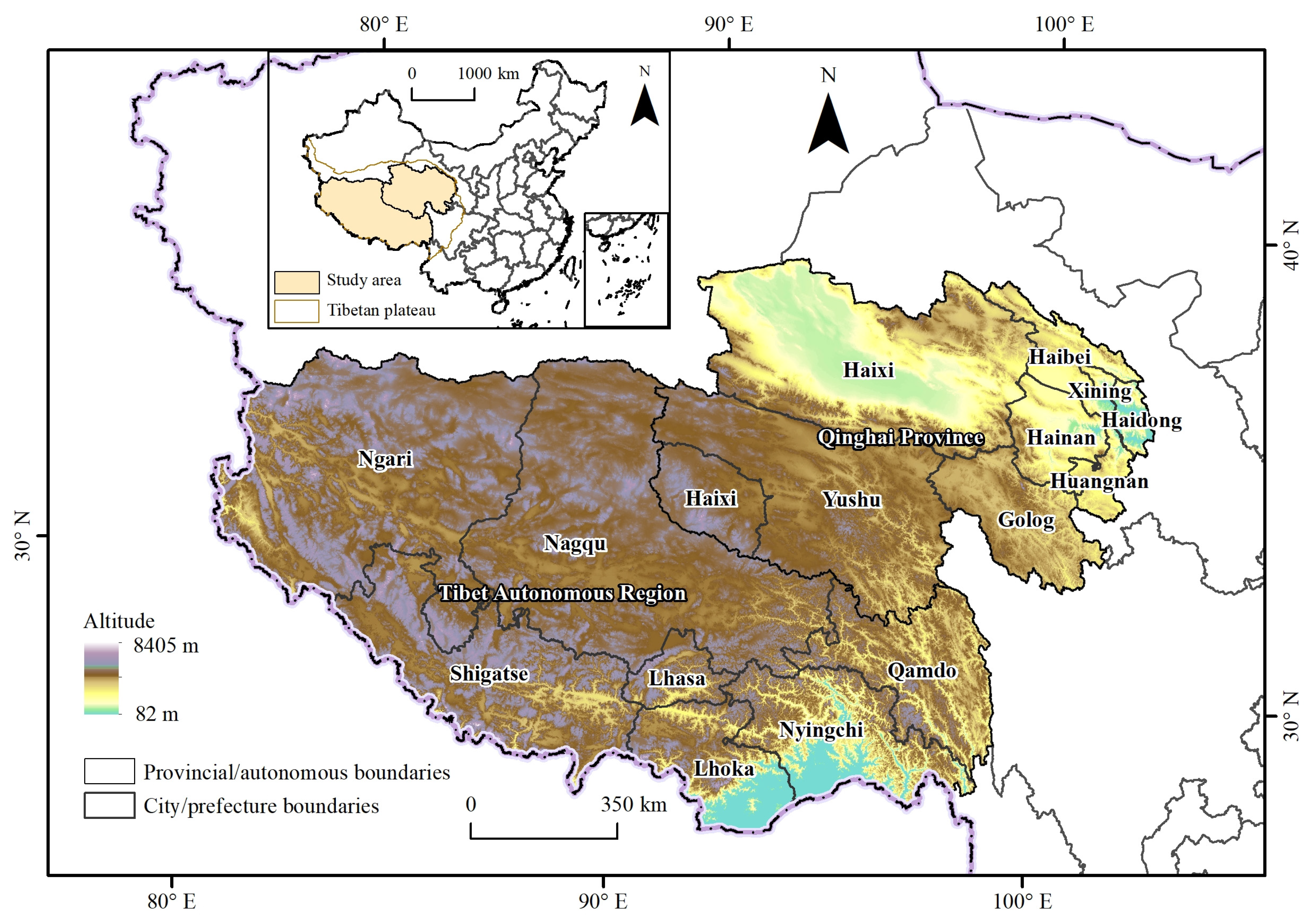
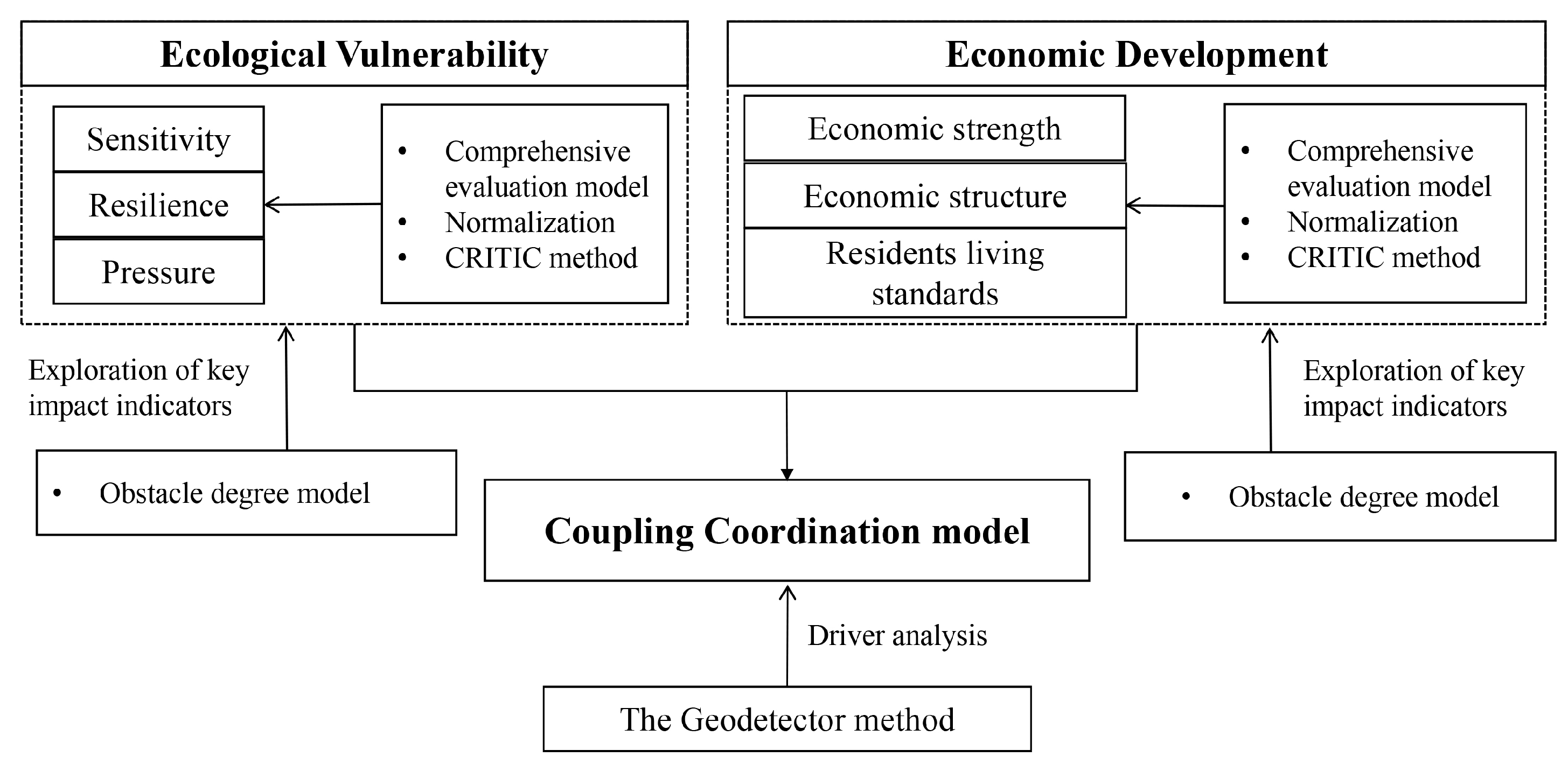
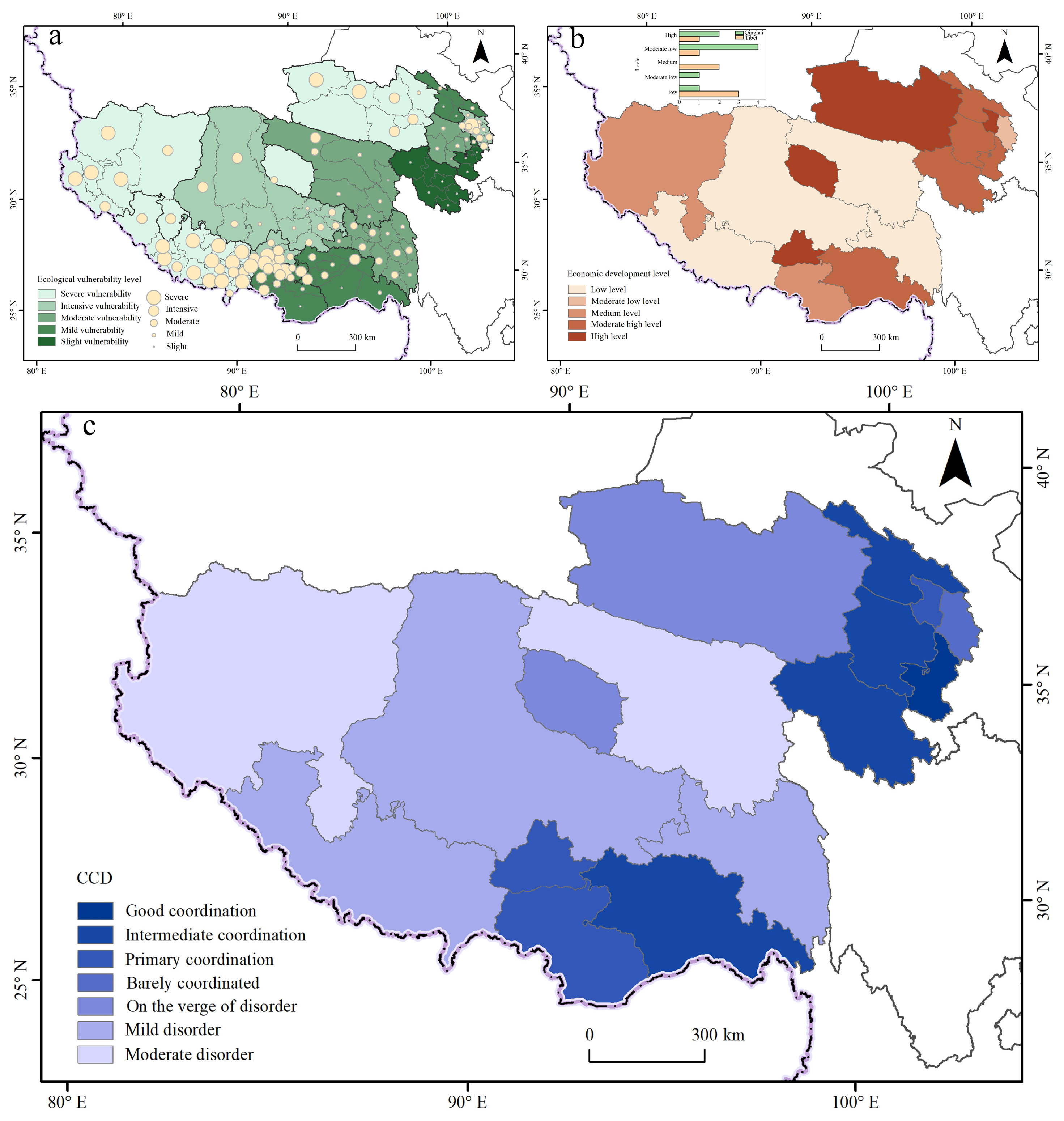
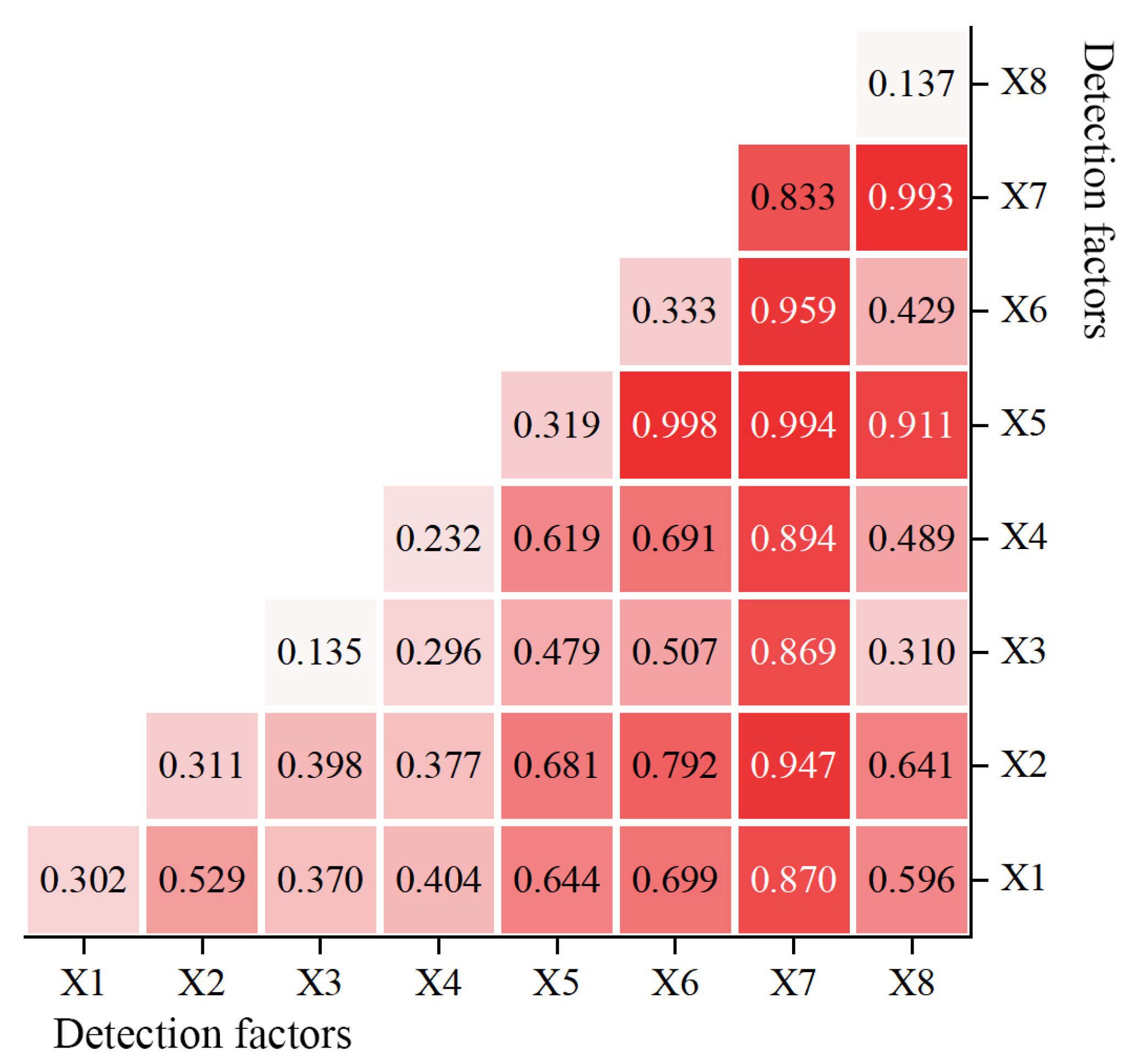
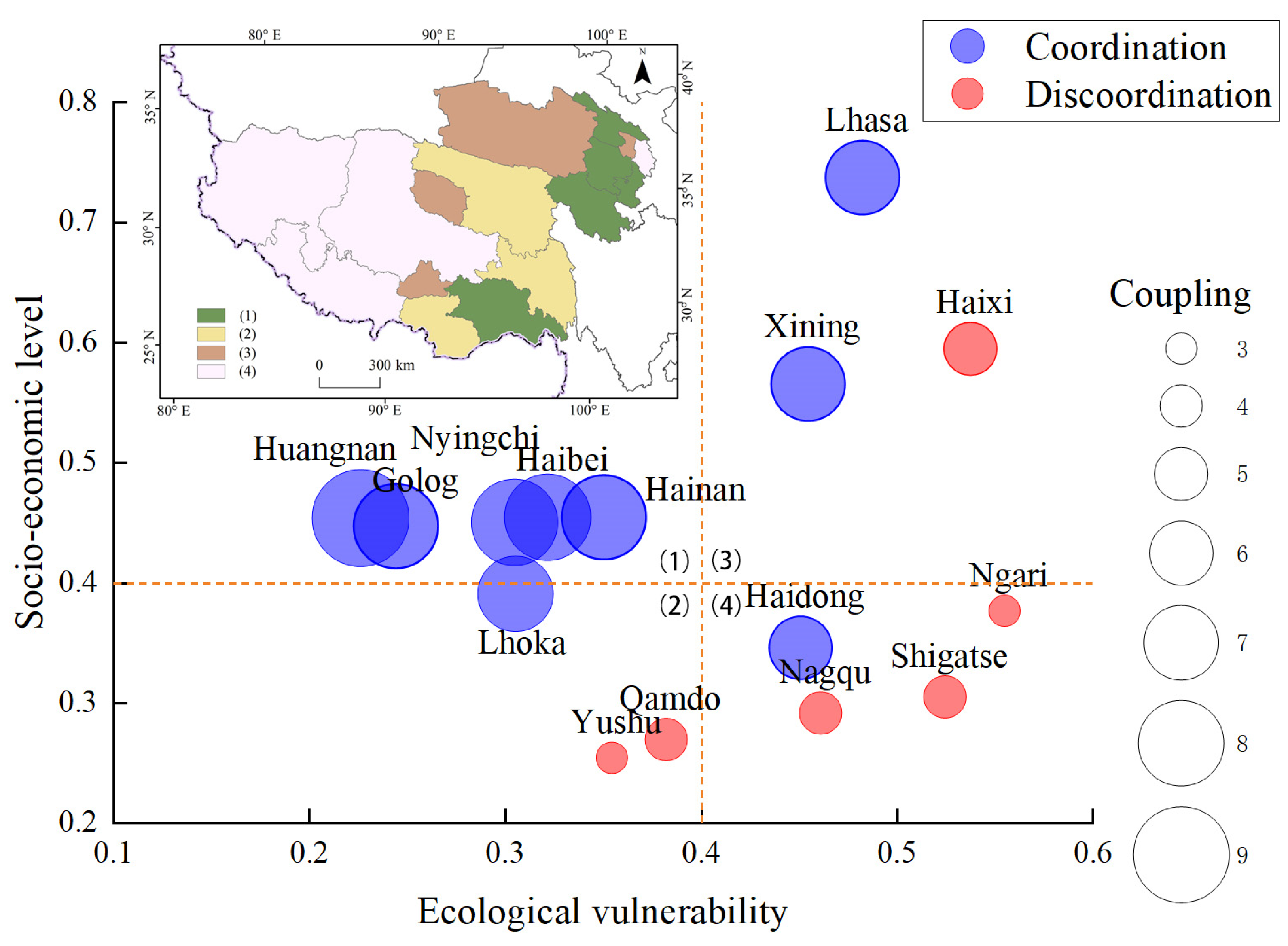
| Serial Number | City | Abbreviation |
|---|---|---|
| 1 | Xining city | Xining |
| 2 | Haidong city | Haidong |
| 3 | Haibei Tibetan Autonomous Prefecture | Haibei |
| 4 | Huangnan Tibetan Autonomous Prefecture | Huangnan |
| 5 | Golog Tibetan Autonomous Prefecture | Golog |
| 6 | Hainan Tibetan Autonomous Prefecture | Hainan |
| 7 | Yushu Tibetan Autonomous Prefecture | Yushu |
| 8 | Haixi Mongol and Tibetan | Haixi |
| 9 | Lhasa city | Lhasa |
| 10 | Shigatse city | Shigatse |
| 11 | Qamdo city | Qamdo |
| 12 | Nyingchi city | Nyingchi |
| 13 | Lhoka city | Lhoka |
| 14 | Nagqu city | Nagqu |
| 15 | Ngari Prefecture | Ngari |
| Specific Data | Resolution | Source |
|---|---|---|
| Temperature [37] | 1 km | A Big Earth Data Platform for Three Poles |
| Precipitation [38] | 1 km | A Big Earth Data Platform for Three Poles |
| Evapotranspiration [39] | 1 km | National Tibetan Plateau Data Center |
| Digital elevation model (DEM) [40] | 1 km | Resource and Environment Science and Data Center |
| Fractional vegetation cover (FVC) [41] | 250 m | National Tibetan Plateau Data Center |
| Normalized difference vegetation index (NDVI) [42] | 250 m | National Tibetan Plateau Data Center |
| Net primary productivity of vegetation (NPP) [43] | 1 km | National Aeronautics and Space Administration (NASA) |
| Spatial distribution of soil erosion [44] | 1 km | Resource and Environment Science and Data Center |
| Land use/cover change (LUCC) [45] | 1 km | Resource and Environment Science and Data Center |
| Serial Number | Criterion | Indicator | Calculation Formula | Remarks |
|---|---|---|---|---|
| 1 | Sensitivity | Annual average temperature | Where is the value of the th pixel, is the number of pixels in the region, and is the regional average. | |
| 2 | Annual average precipitation | |||
| 3 | Potential evapotranspiration | |||
| 4 | Elevation | |||
| 5 | Slope | |||
| 6 | Resilience | Fractional vegetation cover (FVC) | ||
| 7 | Normalized difference vegetation index (NDVI) | |||
| 8 | Net Primary Productivity (NPP) | |||
| 9 | Habitat quality | Calculated using the InVEST 3.13.0 model. | ||
| 10 | Habitat degradation | |||
| 11 | Pressure | Soil erosion degree | Soil erosion degree levels: slight 0.2, mild 0.4, moderate 0.6, severe 0.8, extreme 1. | |
| 12 | Land use and land cover | Expert scoring method values: water bodies 0.2, forest land 0.4, grassland 0.6, arable land 0.8, construction land/permanent glaciers/bare land 1. | ||
| 13 | Human disturbance index | (Cultivated land area + Construction land)/Total area of the study region |
| Serial Number | Criterion | Indicator |
|---|---|---|
| 1 | Economic strength | Per capita GDP (CNY) |
| 2 | Per capita total retail sales of consumer goods (CNY) | |
| 3 | Fixed asset investment growth rate (%) | |
| 4 | Per capita fiscal income (CNY) | |
| 5 | Economic structure | Proportion of the primary industry to GDP (%) |
| 6 | Proportion of the secondary industry to GDP (%) | |
| 7 | Proportion of the tertiary industry to GDP (%) | |
| 8 | Total tourism revenue (CNY) | |
| 9 | Residents living standards | Urbanization rate (%) |
| 10 | Per capita disposable income of residents (CNY) | |
| 11 | Per capita household consumption expenditure (CNY) |
| Serial Number | Type of Degree | Value of Coupled Coordination |
|---|---|---|
| 1 | Extreme disorder | 0.0 ≤ D ≤ 0.1 |
| 2 | Severe disorder | 0.1 < D ≤ 0.2 |
| 3 | Moderate disorder | 0.2 < D ≤ 0.3 |
| 4 | Mild disorder | 0.3 < D ≤ 0.4 |
| 5 | Verging on disorder | 0.4 < D ≤ 0.5 |
| 6 | Barely coordinated | 0.5 < D ≤ 0.6 |
| 7 | Primary coordination | 0.6 < D ≤ 0.7 |
| 8 | Intermediate coordination | 0.7 < D ≤ 0.8 |
| 9 | Good coordination | 0.8 < D ≤ 0.9 |
| 10 | High-quality coordination | 0.9 < D ≤ 1.0 |
| Serial Number | Factor Name | Detection Factor |
|---|---|---|
| 1 | Elevation | X1 |
| 2 | Annual average temperature | X2 |
| 3 | Annual average precipitation | X3 |
| 4 | NDVI | X4 |
| 5 | Per capita GDP | X5 |
| 6 | Urbanization rate | X6 |
| 7 | Primary | X7 |
| 8 | Secondary | X8 |
| Detection Factors | X1 | X2 | X3 | X4 | X5 | X6 | X7 | X8 |
|---|---|---|---|---|---|---|---|---|
| q statistic | 0.30 | 0.31 | 0.14 | 0.23 | 0.32 | 0.33 | 0.83 | 0.14 |
| p value | 0.00 | 0.00 | 0.00 | 0.00 | 0.00 | 0.00 | 0.00 | 0.00 |
Disclaimer/Publisher’s Note: The statements, opinions and data contained in all publications are solely those of the individual author(s) and contributor(s) and not of MDPI and/or the editor(s). MDPI and/or the editor(s) disclaim responsibility for any injury to people or property resulting from any ideas, methods, instructions or products referred to in the content. |
© 2024 by the authors. Licensee MDPI, Basel, Switzerland. This article is an open access article distributed under the terms and conditions of the Creative Commons Attribution (CC BY) license (https://creativecommons.org/licenses/by/4.0/).
Share and Cite
Wang, J.; Wu, S.; Liu, L.; Yan, R.; Zhou, S. Coupling Coordination Relationships Between Ecosystems and Economic Development in Qinghai and Tibet. Land 2024, 13, 1766. https://doi.org/10.3390/land13111766
Wang J, Wu S, Liu L, Yan R, Zhou S. Coupling Coordination Relationships Between Ecosystems and Economic Development in Qinghai and Tibet. Land. 2024; 13(11):1766. https://doi.org/10.3390/land13111766
Chicago/Turabian StyleWang, Jie, Shaohong Wu, Lulu Liu, Rui Yan, and Shuang Zhou. 2024. "Coupling Coordination Relationships Between Ecosystems and Economic Development in Qinghai and Tibet" Land 13, no. 11: 1766. https://doi.org/10.3390/land13111766
APA StyleWang, J., Wu, S., Liu, L., Yan, R., & Zhou, S. (2024). Coupling Coordination Relationships Between Ecosystems and Economic Development in Qinghai and Tibet. Land, 13(11), 1766. https://doi.org/10.3390/land13111766







